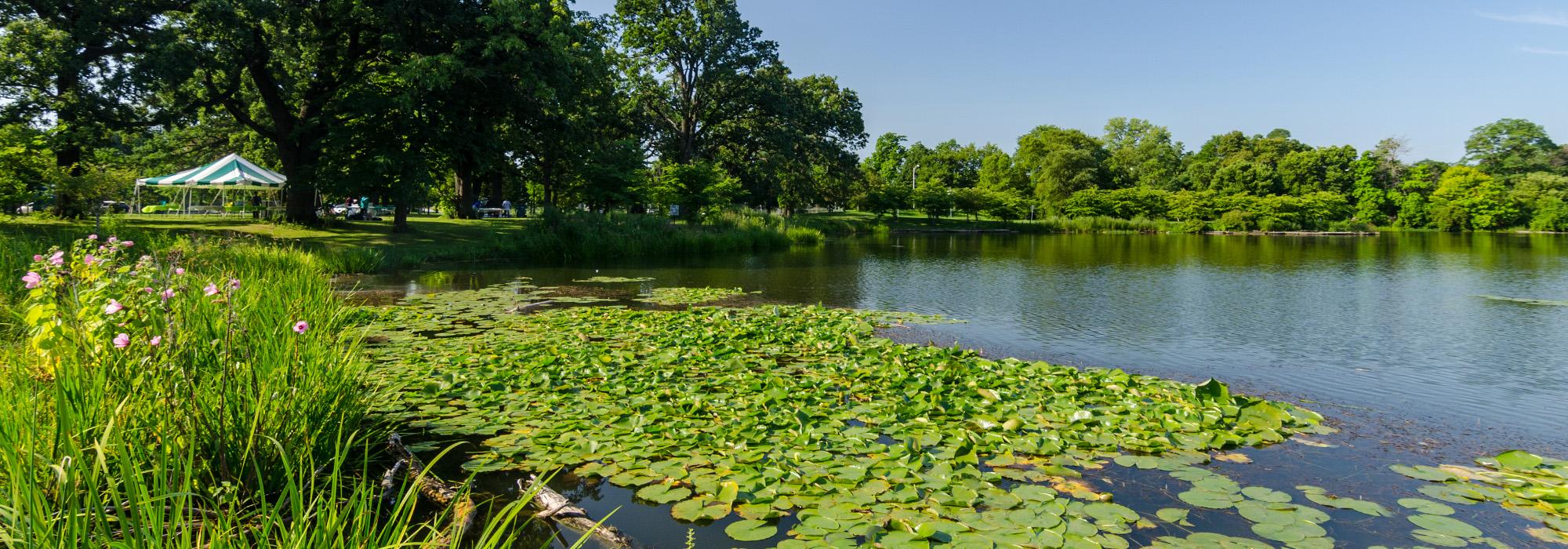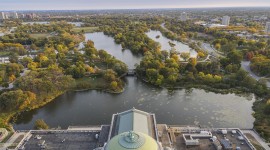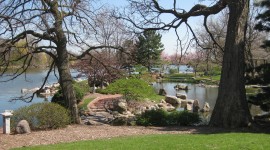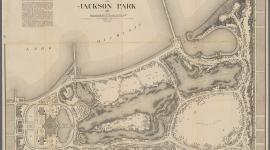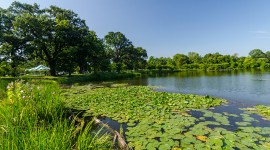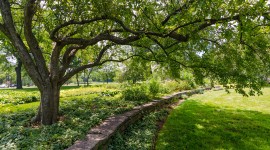TCLF Responds to “Report and Opinion” on Effects of OPC
Editor's Note: On March 22, 2019, the Obama Foundation issued a press release entitled “Jackson Park: The Right Choice,” which announced that the foundation was publicly releasing five documents pertaining to a lawsuit stemming from the proposed construction of the Obama Presidential Center in Jackson Park in Chicago, Illinois. One of the documents, the “Report and Opinion…,” was “undertaken at the request of Richard F. Friedman of the law firm of Neal & Leroy, LLC, on behalf of the Barack Obama Foundation.” The report indicates that “the assignment was to investigate the proposed Obama Presidential Center master plan and to assess the effect of the project on the historic cultural landscape of Jackson Park, Chicago, a park listed on the National Register of Historic Places.” What follows here is TCLF’s response to that report.
* * * * *
April 11, 2019
To begin, a point of clarification is essential regarding the nature of the above-referenced report. It must be emphasized that what the author has produced is not a Cultural Landscape Report (CLR), which is the accepted standard for documenting and assessing cultural landscapes, with methods and procedures delineated by the National Park Service; rather, it is a unique “Report and Opinion” solicited by a private party (the law firm representing the Obama Foundation) whose primary interest in doing so is the furtherance of plans to build the OPC in Jackson Park. The document is not, therefore, held to any overarching standards of accuracy or bias, nor is it governed by the procedural or professional norms associated with CLRs. As much is evinced by the fact that the author was also specifically contracted to write, in this same document, opinions about the OPC’s “compatibility with basic policies of the Lakefront Plan of Chicago and the purposes of the Lake Michigan and Chicago Lakefront Protection Ordinance,” and about legal questions of land ownership, etc.—questions well beyond the realm of the historicity of Jackson Park as a designed landscape or cultural resource.
Before addressing the document’s treatment of several key topics, the fundamental flaw in its approach is revealed by posing a single methodological question: Using the author’s mode of analysis, would placing any building of any size or description west of Cornell Drive in Jackson Park adversely affect the park’s design intent or character-defining features? Based on this document’s limited scope of analysis, the answer would be ‘No.’ That is because there is no attempt to assess the impact of the OPC tower on overarching visual and spatial relationships inherent in the designs of Jackson Park and the Midway Plaisance; in fact, there is no attempt to assess visual or spatial relationships in the parks at all, despite the author’s claim to rely on the Secretary of the Interior’s Standards for the Treatment of Historic Properties with Guidelines for the Treatment of Cultural Landscapes, in which such relationships are of paramount importance. Because it is unmoored from any comprehensive method of visual or spatial analysis, the report makes highly conjectural or specious claims, such as when it contends that, because temporary Beaux-Arts buildings were constructed in Jackson Park during the World’s Columbian Exposition of 1893, placing permanent, Modernist, high-rise buildings in the park today, such as the OPC tower, would, therefore, honor the park’s design intent (for more on this point, see below).
The Nature of the OPC:
The first of the author’s conclusions (p. 1) is that the OPC campus and grounds will be “designed and developed for public purposes similar to the rest of the cultural facilities throughout the Chicago park system.” But the OPC would not be similar to any other cultural institution in the Chicago park system, because, as a “presidential center” and “citizenship campus,” it will clearly embody a political agenda that many Chicagoans will choose to avoid. Indeed, the Obama Foundation has made no attempt—nor could it—to disguise the fact that a fundamental purpose of the OPC campus is to present the legacy of former President Barack Obama; but not all Chicagoans identify with that legacy, and some reject it outright. TCLF has written elsewhere about the implicit political agendas that undergird presidential libraries, let alone a “presidential center,” as opposed to parkland, which has no political agenda and can be enjoyed equally by all members of the public. This important difference is glossed over throughout the document, as when the author further concludes (p. 3, #10) that the OPC would continue “a heritage of pairing of [sic] cultural institutions and parks…” and that (pp. 5, 28) the OPC is thus comparable to the Lincoln Park Zoo, the Chicago Historical Society, or the Museum of Science and Industry. But that assertion has been thoroughly dismantled in an amicus curiae brief filed by Preservation Chicago and Jackson Park Watch in the lawsuit opposing the OPC's construction in Jackson Park, which demonstrates that not one of Chicago's eleven so-called "Park Museums" was built anew on existing parkland.
Devaluing the Parkland West of Cornell Drive:
In both its implicit framework and explicit statements, the document consistently attempts to devalue the parkland west of Cornell Drive by presenting it as marginalized space. The author states (p. 2, #6) that the OPC respects the design intent of the 1895 plan because it is “planned to be within one of the perimeter sites of the 1895 plan which were intended to provide a designed transition to the main spatial/activity structure of the central portions of the park—the Lagoons and Fields” (emphasis added). Although to our knowledge, the term “perimeter site” does not derive from any historical document related to the park’s design, its use throughout the report tends, of course, to diminish the historical significance of the parkland that the OPC intends to occupy. The document further asserts (p. 23) that “the gymnasia site [west of Cornell Drive] was fenced off from the rest of the park, connecting its use more to the surrounding neighborhood than the park landscape” and goes on to say—astonishingly—that the fence line and gates drawn on the 1895 plan “place the proposed site of the open-air gymnasia outside the bounds of the park” (p. 35, emphasis added). While the 1895 plan does show a picket fence surrounding the gymnasia and the children’s playground, the leap to the assertion that those spaces were in any way outside the bounds of the park is without foundation and, moreover, plainly refuted by the fact that the parkland in question is included in every known drawing, sketch, and plan of Jackson Park.
To further distance the proposed OPC site from the park’s historically significant design, the author states (p. 10) that the open-air gymnasia in Jackson Park “were never completed” and (p. 24) that when Olmsted wrote in correspondences about the gymnasia, he was referring “to the equipment and facilities proposed, not the ground/space.” How the author has intuited what Olmsted meant by “open-air gymnasia” is never revealed; but given that the most obvious necessity for open-air gymnasia of any era is a ground plan, the presence or absence of original play equipment, temporary and interchangeable by nature, is hardly relevant to an assessment of the park’s historic, designed landscape. Moreover, we need not read Olmsted’s mind to know that the designed landscape for the open-air gymnasia was completed in Jackson Park, because contemporaneous reports that give an account of the groundwork (completed in 1896) and the installation of oval running tracks (soon used instead by cyclists) survive in park records. The Chicago Park District’s own historical assessment of Jackson Park says the following:
The outdoor gymnasia area was one of the first sections of Jackson Park to be improved following the adoption of the Olmsted, Olmsted & Eliot plan. The gravel used for grading and surfacing the outdoor gymnasia were taken from the World's Fair walks (SPC Annual Report 1894-5, 8). Soon after the outdoor gymnasia were opened to the public, the gravel running tracks began to be used as bicycle tracks (Report of SPC 1895, 9, emphasis added).
Whether or not play equipment was installed at the site of the gymnasia is irrelevant to assessing the design intent of the landscape west of Cornell Drive, which is directly attested by Olmsted’s surviving correspondences as well as the 1895 plan for the park. What also survives today from the original design of the gymnasia are the current walking paths opposite East 62nd Street, which retain the footprint of those encircling the children’s playground in the 1895 plan. But the “Report and Opinion” does not mention the historical value of those pathways or of the oval outline of the north gymnasium, which is echoed by the current running track. It does, however, assure the reader that “the sunken landform of the round turning basin proposed in the 1895 plan and in the 1936 design for the Perennial Garden is expressed in the [OPC’s] proposed Women’s Garden.” But why does the document acknowledge the importance of the “sunken landform” that recalls a historical garden while ignoring the paths and walkways—that today can be directly overlaid with the 1895 plan for Jackson Park—that the OPC will obliterate? That omission betrays the purpose of the document itself and indicates that it is not a reliable assessment of the historic, designed landscape, not least because it does not consistently apply its own analytical criteria: If the round form of the turning basin is a historic landscape feature worth preserving, then so, too, are the oval outline of the north gymnasium and the U-shaped form of the pathways surrounding the children’s playground.
The Effects of the OPC Tower:
By far the most consequential shortcoming of the document is the absence of an analysis of the effects of the OPC tower on the visual and spatial relationships expressed in the historic design of Jackson Park. The author writes (p. 1) that the design of the OPC “respects the formal juncture of the Midway Plaisance and entrance to Jackson Park” and that it “frames this gateway site, but does not interrupt.” A less anodyne and more accurate description would say simply that the OPC tower does not physically block the juncture of the Midway Plaisance and Jackson Park. Elsewhere (p. 3, #8) the document states that the OPC “does not encroach into the central lagoon, field, drive, or lakefront landscapes so critical to the historic fabric of the park.” The analysis in the document is thus repeatedly restricted to the physical placement of the proposed OPC buildings and avoids any discussion of their indirect or cumulative spatial and visual effects on the park’s character-defining features.
Indeed, the physical footprint (but not the height or other characteristics) of the OPC Tower would appear to be the only aspect of the proposed construction that the author is willing to assess, except when he reports (p. 2, #4) that “views of portions of the Obama Presidential Center, especially the tower, resemble the Frederick Law Olmsted design intent for Wooded Island, which was created to be experienced in designed contrast to the immense and highly visible Fair structures.” That statement deserves magnification. The author appears to claim that the OPC tower, a permanent, 235-foot-high, Modernist structure, is akin to the temporary, low-rise Beaux-Arts buildings of the World’s Columbian Exposition of 1893 and is therefore compatible with the original design intent of Wooded Island, which the author identifies (p. 9) as “the true legacy in the park of the work of Frederick Law Olmsted.” By that logic, if fourteen new high-rise buildings were built in the locations of the major temporary Fair buildings of 1893, the effect would be to enhance and evoke the original design intent for the Wooded Island—a notion that strains credulity and hardly requires serious refutation.
Moreover, the document states (p. 3, #9) that “in both the 1871 and 1895 plans, the area proposed for the siting of the Obama Presidential Center was indicated to be a landscaped perimeter, a buffer zone providing the transition from City to Park.” Putting aside the reduction of the parkland west of Cornell Drive to a “buffer zone,” the question remains: Is the author now claiming that, in keeping with the 1871 and 1895 plans, the OPC will act as a buffer between the park and the surrounding neighborhood? Has the author, therefore, abandoned the position that the OPC is akin to the “immense and highly visible Fair structures” of the 1893 plan for the World’s Columbian Exposition? Which plan for the park—the 1871, 1893, or 1895 plan—is the author using as a baseline of analysis? It would appear that the answer to that question varies according to the need to cast the OPC in the most favorable light.
For all the document’s claims that the OPC is compatible with the intent of the park’s original designers, which the author has discerned in part by consulting the “principals of the architectural and landscape architectural design team [of the OPC]” (p. 2), it fails to mention the most direct evidence that bears precisely on the question of design intent, evidence that does not require visual interpretation, intuition, or deep historical research: As is by now well-known, on May 7, 1894, Frederick Law Olmsted, Sr., wrote that the Field Columbian Museum was meant to be the only “dominating object of interest” in Jackson Park:
All other buildings and structures to be within the park boundaries are to be placed and planned exclusively with a view to advancing the ruling purpose of the park. They are to be auxiliary to and subordinate to the scenery of the park (emphasis added).
Could any credible effort to assess the design intent behind the park’s many historical layers fail to mention such a direct and relevant statement, which communicates unequivocally an important—indeed, prescient—aspect of the original design intent of Frederick Law Olmsted, Sr.? And can it be argued with any conviction that the OPC tower, which is most frequently described as being analogous to “a beacon,” would be “auxiliary to the scenery of the park”? The report reaches no conclusions on these points because it does not mention them at all.
Applying the Proper Standards in Evaluating a Cultural Landscape
In a section titled ‘Methodology’ (p. 3), the document states that accepted standards for assessing historic, designed landscapes were used, including, among a litany of resources from the National Park Service, the Secretary of the Interior’s Standards for the Treatment of Historic Properties with Guidelines for the Treatment of Cultural Landscapes. The Guidelines are indeed the accepted standard for treating cultural landscapes listed in the National Register of Historic Places, but it is telling that they are only mentioned once again, when the author states generally (p. 15) that his evaluation has been “filtered through” them—a vague term that is never clarified. But nowhere in the document are the Guidelines applied as a mode of analysis and evaluation to any feature or aspect of Jackson Park potentially affected by the OPC.
As background, the Guidelines are organized in two primary areas: [1] Organizational Elements of the Landscape and [2] Character-Defining Features of the Landscape. Jackson Park’s character-defining features include the flat topography of its fields and open spaces, its interior waterways, and the backdrop or “borrowed view” of Lake Michigan—all elements that contribute to the harmony of the overarching design. The flatness of the ground plane—a direct reference to the landscape of the Heartland—is a character-defining feature of the park and was, indeed, the primary characteristic that Olmsted’s design was meant to overcome by linking a system of lagoons to Lake Michigan. The imposition of a 235-foot-high tower would introduce a dominant vertical axis that would reorient the visual experience of the landscape to focus on a singular architectural element. The “Report and Opinion” is, however, silent on the OPC tower’s effect on the park’s generally flat, character-defining topography and on the extent to which it would constitute a “dominating object of interest.”
Nor does the document evaluate the effects of the shadows cast by the tower on the park, or the effects of its reflection in the nearby lagoons, which were meant to evoke a natural setting by reflecting only the vegetation and sky that surrounds them. As scholar Daniel Bluestone has noted about Jackson Park, “lagoons and lakes that would reflect the foliage provided intricacy and picturesque variety—elements often tamed in other Olmsted designs.” Moreover, the waterways were meant to “provide a sense of indirection, subtlety, and leisure; they fostered a sense of time and motion that contrasted dramatically with the experience of the city’s street grid.” The monolithic OPC tower would also, of course, loom large over the Wooded Island, destroying its quality as a place of refuge and its “secluded, natural sylvan” character, as Olmsted described it. Furthermore, Jackson Park’s western perimeter was designed to be visually permeable, lined with trees that define the landscape’s perimeter edge while allowing lightly veiled views into the park. The OPC tower and associated buildings would obstruct views into the park and beyond to Lake Michigan from both the Hyde Park and Woodlawn neighborhoods.
Finally, the report’s analysis of the park’s historic roadways is also deficient. For example, the OPC would necessitate the closing of a key segment of the Midway Plaisance South road, which has already been identified in Park District documents as a roadway with historic design integrity deriving from the 1895 plan, and which is the southern, symmetrical counterpart to another road that flanks the Perennial Garden at the juncture of the Midway Plaisance and Jackson Park. But the closing of an historic roadway in Jackson Park would seem to represent no adverse effect whatsoever, according to the report, as it envisions the new arrangement with the OPC: “Pedestrian walkways from south walks of the Midway extend into the park in sweeping geometries which reflect the now vacated alignment of the south Midway Plaisance Drive as it intersected Cornell [emphasis added].” Rather than confronting and analyzing the closing of a roadway that has already been identified as having integrity and associated significance, the report glosses over the proposed change entirely with a florid description of the new OPC landscape—an unconcealed accolade rather than an assessment of an effect.
There will always be differences of opinion, even among recognized experts, about the effects of constructing buildings within historic, designed landscapes. That is precisely why it is important to use established standards, guidelines, and procedures when analyzing and evaluating such potential adverse effects—not because doing so guarantees a universally agreed-upon outcome, but because doing so establishes a baseline for discussion, reasonable disagreement, or consensus. The “Report and Opinion” reviewed here, however, represents no such application of the appropriate standards or guidelines and therefore provides no such baseline.



